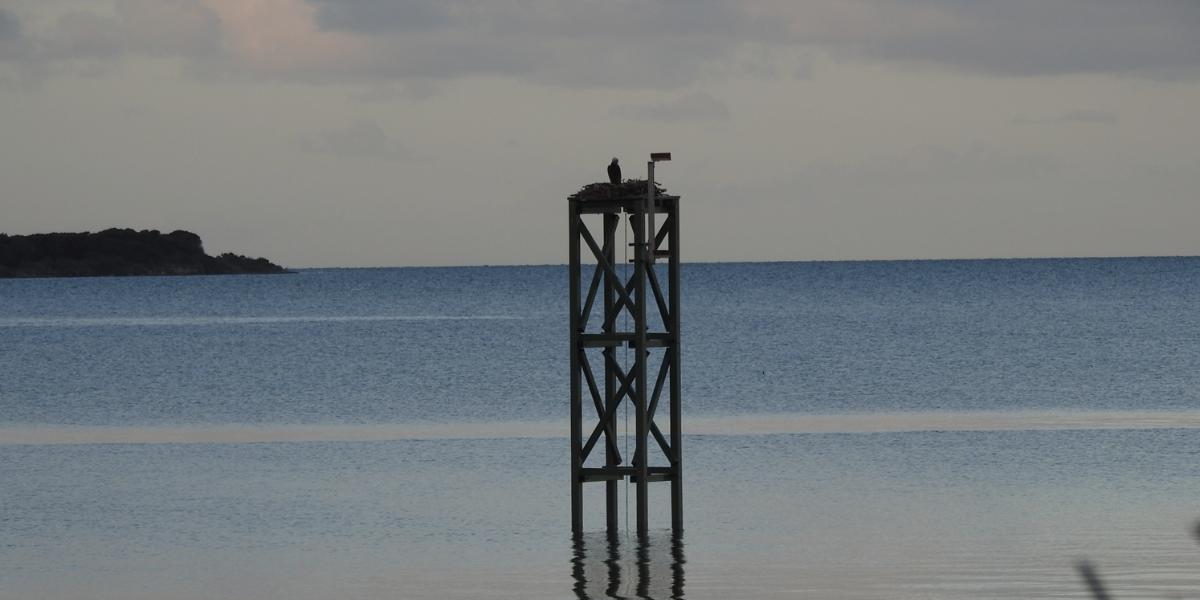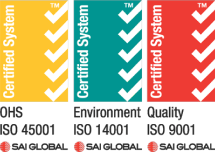A once-declining population of eastern ospreys in South Australia is showing remarkable signs of recovery thanks to a conservation initiative that combines cutting-edge Fibre Reinforced Polymer (FRP) design and community and government collaboration.
With numbers plummeting by 26% over seven years, South Australia’s endangered eastern osprey population was at risk of vanishing altogether.
Coordinator of the Recovery Project for Eastern Osprey in South Australia, Ian Falkenberg said a collection of custom built FRP artificial nest platforms are helping osprey fledglings take flight where nests had long fallen silent.
“The osprey population in South Australia is quite disjunct from the main species distribution in Australia which effectively makes it quite unique in terms of its population status,” Ian Falkenberg said.
“We know that the birds are declining because in 2008/2010 a survey showed around 58 pairs of ospreys in South Australia. A subsequent population survey in 2015/2017 revealed a significant 26% decline with only 43 pairs surveyed,” Mr Falkenberg said.
“All breeding sites on Yorke Peninsula at that time had been abandoned apart from one and the population was in dire straits of collapsing with that sort of decline,” he said.
“As a result of those declines, the South Australian Recovery Plan for Eastern Osprey and White-bellied Sea Eagle was developed and of course, the artificial nest platforms which are a vital and proven form of threat mitigation in areas where limited natural nest sites exist and where food is plentiful was implemented.”
“The project effectively kicked off in 2019 with the Southern Yorke Peninsula Landcare Group initiating the development of a recovery plan and effectively developed some specifications around what was needed to kick off the population itself with artificial nest platforms.”
“There was a fair bit of planning work to go into the establishment of these platforms. We needed development approval, planning applications were submitted to the council and respective government departments of which there were six.”
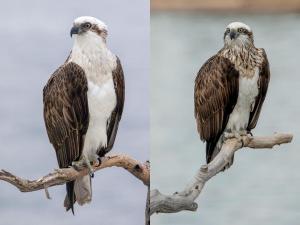 Pictured – Adult male (left) and adult female (right) osprey. Photos by Fran Solly.
Pictured – Adult male (left) and adult female (right) osprey. Photos by Fran Solly.
FRP was selected as the material of choice owing to its superior performance in volatile marine environments.
“The composite fibre technology material was selected for the tower platforms due to its strength, structural integrity, lower cost and ease of fabrication,” Ian Falkenberg said.
“This is very important because initially the engineers developed a platform in steel which was very expensive, needed specialist people to build and also the longevity of steel in a marine environment was questionable,” Mr Falkenberg said.
“Composite fibre was certainly one that ticked all boxes in terms of its durability, strength, lower cost and longevity in a marine environment,” he said.
“Using composite fibre allowed us to be very flexible with where we could put the platforms.”
“We’ve put these platforms in mangrove situations where the substrates are quite deep with mud. We’ve also put the structures on granite rock which presents some incredible challenges in terms of how to anchor a platform in that sort of location.”
“There are many other, more expensive techniques for getting platforms into very rocky landscapes but they’re also very very expensive and certainly well beyond the funding arrangements for this project.”
“Also the platforms can be put into shell grit sand substrates. We’ve done all of those effectively over the 18 platforms, so we’re able to adapt them accordingly based on what sort of environment we’re putting them into and it would be very hard to have that sort of flexibility in other materials.”
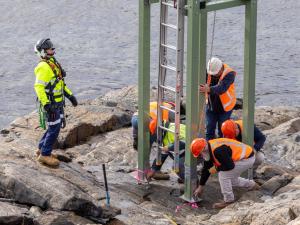 Pictured – Volunteers securing a FRP artificial nest platform using chem-cement and bolted to a slab of granite rock.
Pictured – Volunteers securing a FRP artificial nest platform using chem-cement and bolted to a slab of granite rock.
The Ardrossan Community and Men’s Shed volunteered to lead the fabrication trial and have since built most of South Australia’s 18 FRP artificial nesting platforms.
“We talked to a number of organisations and community men’s sheds around the state and the Ardrossan Community and Men’s Shed were the ones that were willing to give it a go and to trial the production and fabrication of these platforms,” Ian Falkenberg said.
“We’ve got about 18 platforms total around the coast of South Australia and as you can appreciate most of those have been fabricated by the Ardrossan Community and Men’s Shed,” Mr Falkenberg said.
“Great efforts have gone into selecting the sites where these platforms are to be put,” he said.
“The success rates much improved over water and hence the reason that most of them are put into shallow marine environments where there’s less disturbance, away from predation and away from developments such as walking trails and housing developments and so forth.”
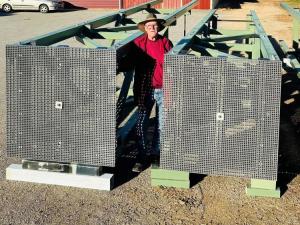 Pictured – Kevin Betterman from Ardrossan Community and Men’s Shed standing with two FRP artificial nest platforms.
Pictured – Kevin Betterman from Ardrossan Community and Men’s Shed standing with two FRP artificial nest platforms.
The implementation of these FRP nest platforms have provided the eastern osprey with a safe, undisturbed environment to nest and produce young, which they have successfully done.
“To give you a perspective of how this has rolled out, the last breeding season 2024, 10 ospreys fledged from four artificial nest platforms on Yorke Peninsula,” Ian Falkenberg said.
“10 years ago there was only one active nest on Yorke Peninsula, now we’ve got four artificial platforms producing young and a fifth platform had birds present on them although they didn’t breed so, that’s an incredible improvement on what we saw around 10 years ago,” Mr Falkenberg said.
“Of the four productive osprey nests, two produced three young and two produced two young each,” he said.
“As all these artificial nest platforms are elevated six and a half meters above the ground, they give the birds an incredible amount of protection from predation and human disturbance, so that’s a key aspect of allowing these birds to breed in safety and free of interference from things below the nest.”
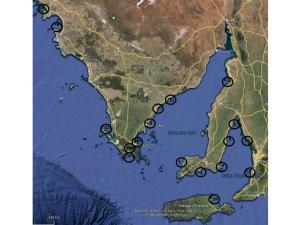 Pictured – A map of the 18 FRP artificial nest platforms located around the South Australian coast.
Pictured – A map of the 18 FRP artificial nest platforms located around the South Australian coast.
Incredible success stories have come from the FRP artificial nests installed at Price, Gleesons Landing, Point Davenport and Coobowie.
“To further give you an indication of the successes, the Price osprey nest which was installed in 2021 produced young almost immediately that season,” Ian Falkenberg said.
“Gleesons Landing osprey nest is another platform we put up in 2022 and this was the first successful breeding of this pair of ospreys in 10 years,” Mr Falkenberg said.
“Another really important outcome of the project was the osprey nest platform installed at Point Davenport in 2022. No ospreys were previously recorded breeding at this site and within a few days of installation a pair of ospreys moved in,” he said.
“2022 was the first year they laid three eggs although the eggs didn’t hatch and that’s not unusual for a first breeding but in 2023 they produced two young and last year they produced three young which again is an outstanding result.”
“Finally, another outstanding outcome in 2023, the Coobowie osprey nest platform was installed and within 4 hours of the installation a pair of ospreys were observed refurbishing the nest.”
“Fast track to 2024, four young were produced at this nest and although only three young fledged, these were the heaviest birds that we’ve actually recorded in an osprey nest since the project commenced so a fantastic result.”
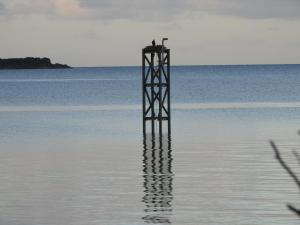 Pictured – An osprey happily nesting on the FRP artificial platform at Coobowie Bay.
Pictured – An osprey happily nesting on the FRP artificial platform at Coobowie Bay.
As FRP is modular and lightweight, the platforms can be easily picked up and relocated should it be required.
“Essentially there’s no guarantee that ospreys will adopt all of these platforms,” Ian Falkenberg said.
“Whilst we can do everything we can to make sure that ospreys have got the best chances of adopting them, there’s no guarantee we’ll see a pair come in to take it on,” Mr Falkenberg said.
“Now we haven’t been faced with this problem before but we could actually pull those platforms out of the sleeves that have been inserted into the substrate and relocate the platform,” he said.
“So that was one of the design flexibilities that we had considered. If it didn’t work after perhaps two or three or four years and circumstances changed, then we could actually effectively easily lift them out and relocate them somewhere else.”
“If we had other materials used, that wouldn’t be possible so there are single poles that have been put in that wouldn’t allow that to happen so the tower composite fibre platforms do give us that flexibility certainly.”
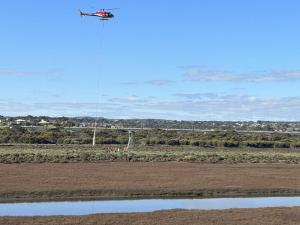 Pictured – FRP osprey nest platform being lifted into position with a helicopter in difficult location along the Onkaparinga River estuary.
Pictured – FRP osprey nest platform being lifted into position with a helicopter in difficult location along the Onkaparinga River estuary.
Djulda-wawa Badja Project Manager, Janet Moore said osprey recovery has been buoyed by funding provided by the South Australian government through the Northern and Yorke Landscape Board.
“Governments invest in threatened species protection and recovery efforts across Australia, and in South Australia, osprey populations have experienced a significant and steady decline and they’ve been classed as endangered in South Australia since 2008,” Janet Moore said.
“In response to the decline in population, an osprey and white-bellied sea eagle recovery plan was published in 2022 by the South Australia’s Department for Environment and Water,” Ms Moore said.
“This plan provides a blueprint for the recovery of both species focusing on identifying the greatest threats to the species, how best to manage them to maintain the current breeding population and where additional targeted actions like artificial nesting platforms can increase breeding success,” she said.
“Over the last three years, the Northern and Yorke Landscape Board has been able to provide financial support to the Southern Yorke Peninsula Landcare Group for the installation of four platforms through our Djulda-wawa Badja Project.”
“The Djulda-wawa Badja Project aims to strengthen our coastal ecosystems on Yorke Peninsula to better withstand the threats of climate change, pest plants and animals, increased vehicle-based recreation and ensuring that First Nations People first nations people are well positioned to shape and participate in the project.”
“The project aims to achieve this through a number of initiatives around visitor management, coastal restoration and supporting community-led resilience projects such as the osprey recovery program.”
“The recovery program encourages local communities, schools and volunteers to become involved in conservation that builds on environmental awareness and understanding and stewardship for these raptors and respect for their habitat.”
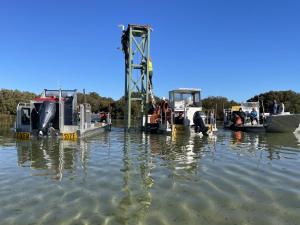 Pictured – Volunteers and oyster farmers installing the FRP osprey nest at Smoky Bay.
Pictured – Volunteers and oyster farmers installing the FRP osprey nest at Smoky Bay.
South Australia’s osprey recovery program offers valuable insights into where artificial nesting platforms could make a real difference.
“When considering whether this program or an artificial nesting platform could be replicated elsewhere, it’s first important to consider the cause of the population decline or lack of breeding success in a particular location or why a particular territory has been abandoned,” Janet Moore said.
“In South Australia’s open low coastal landscapes, osprey and sea eagle nests are particularly vulnerable to disturbance especially from human approach or activity during the breeding season and this can often occur at very long distances,” Ms Moore said.
“So in landscapes where that lack of cover or a lack of suitable nesting habitat exists, then a platform such as the ones manufactured in South Australia could be beneficial so long as the other requirements of the birds were available,” she said.
“The community-led recovery program for ospreys in South Australia has demonstrated that community/government partnerships can be incredibly beneficial for threatened species recovery and I believe this is a model that can be applied elsewhere.”
To read more on the FRP osprey nesting platforms in South Australia https://www.wagnerscft.com.au/frp-elevates-declining-population-of-endangered-eastern-osprey/
If a FRP artificial nest platform could benefit your local osprey population, contact us here https://www.wagnerscft.com.au/contact-us/
To watch a video on ‘Bringing endangered ospreys back to Yorke Peninsula’ https://www.youtube.com/watch?v=mkLHf3YrcMc&t=22s
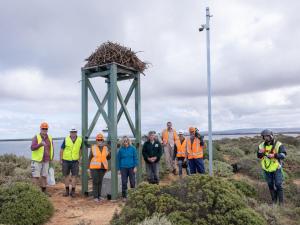 Pictured – A successful FRP artificial nest platform installation at Tumby Island Conservation Park.
Pictured – A successful FRP artificial nest platform installation at Tumby Island Conservation Park.
